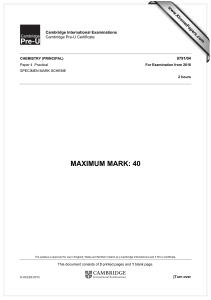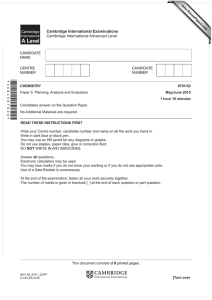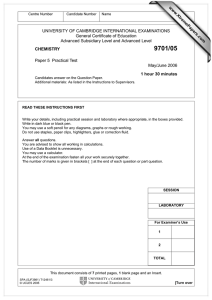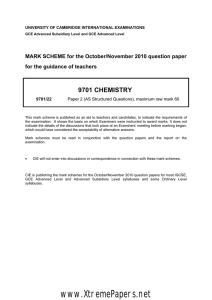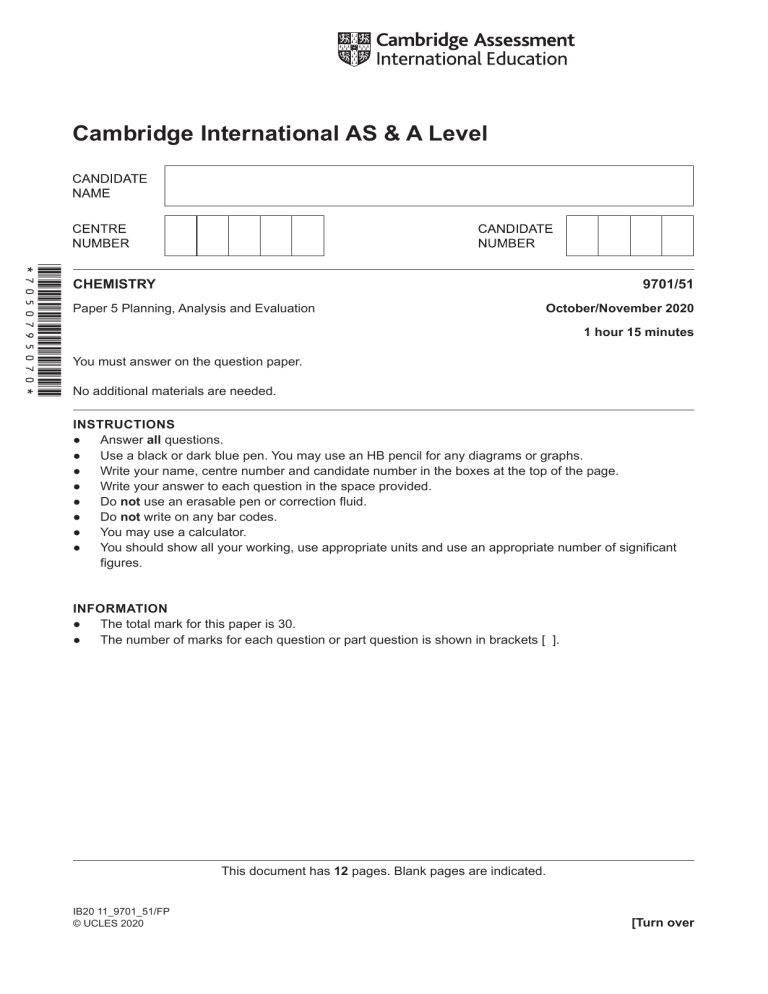
Cambridge International AS & A Level *7050795070* CHEMISTRY9701/51 Paper 5 Planning, Analysis and Evaluation October/November 2020 1 hour 15 minutes You must answer on the question paper. No additional materials are needed. INSTRUCTIONS ● Answer all questions. ● Use a black or dark blue pen. You may use an HB pencil for any diagrams or graphs. ● Write your name, centre number and candidate number in the boxes at the top of the page. ● Write your answer to each question in the space provided. ● Do not use an erasable pen or correction fluid. ● Do not write on any bar codes. ● You may use a calculator. ● You should show all your working, use appropriate units and use an appropriate number of significant figures. INFORMATION ● The total mark for this paper is 30. ● The number of marks for each question or part question is shown in brackets [ ]. This document has 12 pages. Blank pages are indicated. IB20 11_9701_51/FP © UCLES 2020 [Turn over 2 1 Aqueous potassium manganate(VII) can be used to determine the amount of iron present in a sample of iron wire by redox titration. Before potassium manganate(VII) can be used, its concentration must be determined using aqueous sodium ethanedioate made from the hydrated solid Na2C2O4•2H2O. (a) (i) Calculate the mass of Na2C2O4•2H2O required to make 250.0 cm3 of 0.200 mol dm–3 sodium ethanedioate standard solution. [Ar: Na, 23.0; C, 12.0; O, 16.0; H, 1.0] mass of Na2C2O4•2H2O = .............................. g [1] (ii) Describe how the student should accurately prepare 250.0 cm3 of 0.200 mol dm–3 sodium ethanedioate standard solution from the weighed sample of Na2C2O4•2H2O of mass calculated in (a)(i). In your description you should include the names and capacities of any apparatus used. .............................................................................................................................................. .............................................................................................................................................. .............................................................................................................................................. ........................................................................................................................................ [2] (b)Ethanedioate ions, C2O42–(aq), react with manganate(VII) ions, MnO4–(aq), according to the ionic equation shown. 2MnO4–(aq) + 16H+(aq) + 5C2O42–(aq) → 2Mn2+(aq) + 8H2O(l) + 10CO2(g) 25.0 cm3 of 0.200 mol dm–3 C2O42–(aq) required 18.40 cm3 MnO4– (aq) for complete reaction. Calculate the concentration of the aqueous potassium manganate(VII). Give your answer to three significant figures. © UCLES 2020 concentration of aqueous potassium manganate(VII) = .............................. mol dm–3 [3] 9701/51/O/N/20 3 (c)In another experiment, a student uses 0.0200 mol dm–3 MnO4–(aq) to analyse the percentage of iron in a sample of iron wire using the following method. step 1The mass of the iron wire is recorded. step 2The iron wire is dissolved in 20 cm3, an excess, of sulfuric acid and made up to a volume of 250.0 cm3 with distilled water. The iron reacts and dissolves in sulfuric acid to form Fe2+(aq) ions. A 25.0 cm3 sample of this Fe2+ containing solution is titrated with 0.0200 mol dm–3 step 3 MnO4–(aq). The ionic equation for the reaction between MnO4–(aq) and Fe2+(aq) is shown. MnO4–(aq) + 8H+(aq) + 5Fe2+(aq) → Mn2+(aq) + 5Fe3+(aq) + 4H2O(l) The student’s results are shown in the table. [Ar: Fe, 55.8] rough titration 1 titration 2 titration 3 titration 4 final burette reading / cm3 45.50 44.75 44.45 44.80 44.40 initial burette reading / cm3 0.00 0.10 0.15 0.00 0.00 titre / cm3 45.50 44.65 44.30 44.80 44.40 (i)Circle the titres the student should use to obtain the most accurate value for the volume of 0.0200 mol dm–3 KMnO4 that is needed to react with 25.0 cm3 of the prepared iron solution. Explain your answer. .............................................................................................................................................. ........................................................................................................................................ [1] (ii)The burette used for the titration has graduations every 0.10 cm3. Calculate the maximum percentage error in the titre of titration 2. Show your working. © UCLES 2020 percentage error = .............................. [1] 9701/51/O/N/20 [Turn over 4 (iii)Derive an expression to show how you would calculate the percentage by mass of iron in the iron wire. Use x to represent the average titre and y to represent the mass of iron wire used. expression for mass of iron in the iron wire = .............................. [2] (iv)The student left the solution of Fe2+(aq) in sulfuric acid without a stopper for a few days. The student repeated the titration and found that the average titre was lower. Suggest why. .............................................................................................................................................. ........................................................................................................................................ [1] (v)In step 2, the sulfuric acid is used to dissolve the iron in the iron wire. Suggest the other function of the sulfuric acid in this experiment. .............................................................................................................................................. ........................................................................................................................................ [1] (d)Name an appropriate piece of apparatus to measure the volume of sulfuric acid in step 2. Give a reason for your answer. ..................................................................................................................................................... ............................................................................................................................................... [1] © UCLES 2020 [Total: 13] 9701/51/O/N/20 5 Question 2 starts on the next page. © UCLES 2020 9701/51/O/N/20 [Turn over 6 2A student uses the apparatus shown to calculate the relative molecular mass, Mr, of a gaseous alkane. The experiment took place at 298 K and 101 kPa. valve to control flow of gas ALKANE GAS 1 dm3 measuring cylinder filled with water gas cylinder top-pan balance trough containing water The alkane is flammable. The student opens the tap and allows a small amount of the alkane gas into the measuring cylinder, displacing water. The gas in the measuring cylinder is allowed to reach room temperature and the volume recorded. This process is repeated and the measurements of mass of gas cylinder and total volume of gas collected are recorded in the table. A B C mass of gas cylinder / g total volume of gas collected / cm3 total mass of gas lost from the cylinder / g 164.02 0 163.77 100 163.65 150 163.48 230 163.26 320 163.02 420 162.72 550 162.38 720 162.11 800 161.83 930 0.00 (a)Complete column C in the table. The first reading has been done for you. Give all values to two decimal places.[1] (b) (i)Plot a graph on the grid of total mass of gas lost against the total volume of gas collected. ×) to plot each data point. Draw a line of best fit. Use a cross (× © UCLES 2020 9701/51/O/N/20 7 3.00 2.75 2.50 2.25 2.00 1.75 total mass of gas lost / g 1.50 1.25 1.00 0.75 0.50 0.25 0.00 0 200 400 600 800 total volume of gas collected / cm3 © UCLES 2020 9701/51/O/N/20 1000 [2] [Turn over 8 (ii)Circle the point which you think is most anomalous on your graph. [1] (iii)Suggest one reason that explains the anomalous result you have circled. .............................................................................................................................................. ........................................................................................................................................ [1] (c) (i)Use the graph to determine the gradient of the line of best fit. State the coordinates of both points you used in your calculation. These must be selected from your line of best fit. Give the gradient to three significant figures. coordinates 1 ............................................... coordinates 2 ............................................... gradient = .............................. g cm–3 [2] (ii)The ideal gas equation states that pV = nRT, where R = 8.31 J mol–1 K–1. Use the ideal gas equation and your answer to (c)(i) to calculate an experimental value for the Mr of the alkane gas. Give your answer to one decimal place. Show your working. Mr = .............................. [2] (iii)Suggest the identity of the alkane gas. Explain your suggestion. .............................................................................................................................................. ........................................................................................................................................ [1] © UCLES 2020 9701/51/O/N/20 9 (d) (i)Suggest two ways in which the accuracy of the measurements may be improved. .............................................................................................................................................. .............................................................................................................................................. ........................................................................................................................................ [2] (ii)Apart from wearing eye protection or a lab coat, state one safety precaution which the student must take when carrying out this experiment. ........................................................................................................................................ [1] (iii)The student is told that samples of the alkane gas are sometimes contaminated with a more volatile alkane. State and explain how this would affect the gradient of the graph. .............................................................................................................................................. .............................................................................................................................................. ........................................................................................................................................ [2] (iv)In each experiment the gas was allowed to reach the temperature of the room (298 K) before the volume was measured. Explain why this was necessary for the calculation of the Mr of the alkane. .............................................................................................................................................. ........................................................................................................................................ [1] (v)Suggest how the reliability of the experiment could be improved. ........................................................................................................................................ [1] © UCLES 2020 [Total: 17] 9701/51/O/N/20 [Turn over 10 BLANK PAGE © UCLES 2020 9701/51/O/N/20 11 BLANK PAGE © UCLES 2020 9701/51/O/N/20 12 BLANK PAGE Permission to reproduce items where third-party owned material protected by copyright is included has been sought and cleared where possible. Every reasonable effort has been made by the publisher (UCLES) to trace copyright holders, but if any items requiring clearance have unwittingly been included, the publisher will be pleased to make amends at the earliest possible opportunity. To avoid the issue of disclosure of answer-related information to candidates, all copyright acknowledgements are reproduced online in the Cambridge Assessment International Education Copyright Acknowledgements Booklet. This is produced for each series of examinations and is freely available to download at www.cambridgeinternational.org after the live examination series. Cambridge Assessment International Education is part of the Cambridge Assessment Group. Cambridge Assessment is the brand name of the University of Cambridge Local Examinations Syndicate (UCLES), which itself is a department of the University of Cambridge. © UCLES 2020 9701/51/O/N/20
